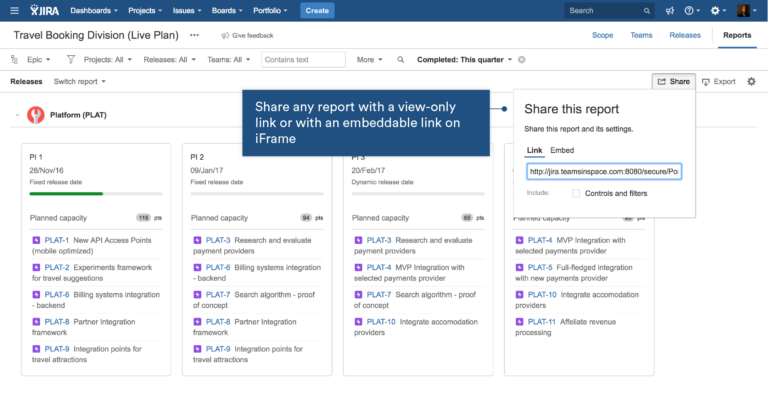The Portfolio for Jira team is excited to announce the release of Portfolio for Jira 2.1 – closing some of our top voted customer feedback on jira.atlassian.com (we’ve been listening!). Portfolio for Jira 2.1 makes planning more contextual with custom fields, labels and components; more flexible with un-estimated items, default estimates, and mixed estimates, and more visible with the ability to share reports with stakeholders. Read on to find out more.
Make planning more contextual
We know you have important information in Jira Software that is crucial to the way your teams plan and make decisions. Using custom fields to track business value? Or, labels and components to track other relevant information? You can now view and edit custom fields, labels, and components directly in Portfolio for Jira.

We’ve also made it possible for you to view your Portfolio-specific fields (i.e. teams and hierarchy levels) on your Jira Software issues. Synchronize your team names as a field in Jira Software — your assigned teams in Portfolio for Jira will be exposed on your Jira Software issue with the new “team field”. And if you’ve created new hierarchy levels in Portfolio for Jira so you can see the bigger picture, you can now view and navigate to your custom hierarchy directly from your Jira Software issues. (PS: both the team field and hierarchy field are JQL searchable!)
Have more flexibility when you plan
Sometimes planning can be so far into the future that you have no idea how much effort will be needed from your teams. In Portfolio for Jira 2.1, you can now plan with un-estimated work items. All you need is the work to be associated with a release or sprint. This is great for starting your roadmap, but remember – if you want your roadmap to be realistic, you’ll need to add estimates eventually. We’ve also brought back the ability to set default estimates for epics, stories and any custom hierarchy too – a popular feature in our classic plans. This can help you plan when you’re not ready to estimate, but need a rough idea of what the plan will look like.

Not all teams work the same and that’s okay. Some teams might plan with time estimates and some might plan with story points, but you might need 1 plan that includes both teams. In Portfolio for Jira 2.1, we’ve now made it possible to plan with mixed estimates. Yes, you can now plan with a mix of story points and time! Easily set conversion ratios between estimate types so that your plan can accommodate both time-based and story point estimates.
Keep everyone on the same page
Next time you’re asked for a progress update, or “when is X releasing?”, you can now share any report from Portfolio for Jira in two different ways: with a view-only link to stakeholders who will see exactly what you shared with the same settings and filters you set, or with an embeddable link to the report view on iFrame. We’ve also introduced CSV export, which allows you to download scope and release reports in CSV format.

If you’re already a Portfolio for Jira customer, you can check out the release notes here. If you’re new to Portfolio for Jira, you can start a free 30 day trial now.
Happy planning! ?
